Invacare Electric wheelchair User Manual
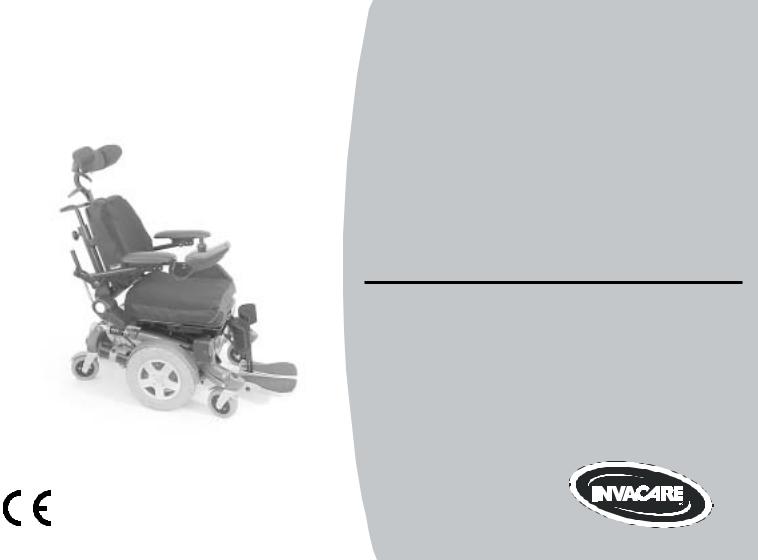
Invacare® Typhoon
Electric wheelchair
Operating manual

How can you get in touch with Invacare®?
If you have any questions or need support, please contact your authorised Invacare® Dealer, who has the necessary know-how and equipment plus the special knowledge concerning your Invacare® product, and can offer you all-round satisfactory service. Should you wish to contact Invacare® directly, you can reach us in Europe at the following addresses and phone numbers.
Invacare® Deutschland GmbH |
|
|
Invacare® A/S |
|
||
Kleiststraße 49 |
|
|
|
|
Sdr. Ringvej 39 |
|
32457 Porta Westfalica |
|
|
|
|
2605 Brøndby |
|
Deutschland |
|
|
|
|
Danmark |
|
(Kundendienst): |
+49 |
- (0) 5731 |
- 754 580 |
(Kundeservice): |
+45 - (0) 3690 0000 |
|
(Technische Hotline): |
+49 - (0) 5731 |
- 754 570 |
Fax (Kundeservice): |
+45 - (0) 3690 0001 |
||
Fax (Kundendienst): |
+49 |
- (0) |
5731 |
- 754 216 |
|
|
Fax (Technische Hotline):+49 - (0) |
5731 |
- 754 208 |
|
|
||
Invacare®, SA c/ Areny, s/n
Poligon Industrial de Celrà 17460 Celrà (Girona)
ESPAÑA |
|
: |
+34 - (0) 972 - 49 32 00 |
Fax: |
+34 - (0) 972 - 49 32 20 |
Invacare® Ltd
South Road
Bridgend
Mid Glamorgan - CF31-3PY
United Kingdom
(Customer Service): +44 - (0) 1656 - 647 327
Fax (Customer Service): +44 - (0) 1656 - 649 016
Invacare® POIRIER
Les Roches
F-37230 Fondettes
France
(Service Après-Vente):+33 - (0) 2 47 - 62 64 66
Fax (Service Après-Vente):+33 - (0) 2 47 - 42 12 24
Invacare Mecc San s.r.l. |
|
Via Dei Pini, 62 |
|
I - 36016 Thiene (VI) |
|
ITALIA |
|
: |
+39 - (0) 445-380059 |
Fax: |
+39 - (0) 445-380034 |
2

Invacare® AS |
|
Grensesvingen 9 |
|
0603 Oslo |
|
Norge |
|
(Kundeservice): |
+47 - 22 57 95 10 |
Fax (Kundeservice): |
+47 - 22 57 95 01 |
Invacare® PORTUGAL Lda
Rua Senhora de Campanhã, 105
4369-001 Porto |
|
PORTUGAL |
|
: |
+351-225105946 |
Fax: |
+351-225105739 |
Invacare® n.v. |
|
Autobaan 14 |
|
8210 Loppem (Brugge) |
|
BELGIUM |
|
: |
+32 (50) 831010 |
Fax: |
+32 (50) 831011 |
Invacare® B.V. |
|
Celsiusstraat 46 |
|
NL-6716 BZ Ede |
|
The Netherlands |
|
: |
+31 - (0) 318 - 69 57 57 |
Fax: |
+31 - (0) 318 - 69 57 58 |
|
|
Invacare® AB |
|
Fagerstagatan 9 |
|
163 91 Spånga |
|
Sverige |
|
(Kundtjänst): |
+46 - (0) 8 761 70 90 |
Fax (Kundtjänst): |
+46 - (0) 8 761 81 08 |
sweden@invacare.com |
|
Service |
|
Invacare |
|
JÄRFÄLLA |
|
: |
+46 - (0) 8 – 621 08 44 |
Fax: |
+46 - (0) 8 – 621 08 45 |
Invacare.jarfalla@.swipnet.se |
|
MÖLNDAL |
|
: |
+46 - (0) 31 – 86 36 00 |
Fax: |
+46 - (0) 31 – 86 36 06 |
invacare.goteborg@swipnet.se |
|
LANDSKRONA |
|
: |
+46 - (0) 418 – 285 40 |
Fax: |
+46 - (0) 418 – 180 89 |
invacare.la@swipnet.se |
|
OSKARSHAMN |
|
: |
+46 - (0) 491 – 101 40 |
Fax: |
+46 - (0) 491 – 101 80 |
invacare.O-hamn@swipnet.se
3

Table of Contents
Chapter Page
1 |
Introduction |
8 |
||
|
1.1 |
Important symbols in this manual ......................................................................................... |
10 |
|
|
1.2 |
Type Classification and Area of Use ..................................................................................... |
11 |
|
|
|
1.2.1 |
Permissable operating conditions................................................................................. |
11 |
|
|
1.2.2 |
Indications..................................................................................................................... |
12 |
2 |
Safety Notes |
13 |
||
|
2.1 |
General Safety Notes .............................................................................................................. |
13 |
|
|
2.2 |
Safety Information on Electromagnetic Interference........................................................... |
16 |
|
|
2.3 |
Safety Information on Driving and Freewheel Mode............................................................ |
17 |
|
|
2.4 |
Safety Information on Wheelchairs with a Lifter.................................................................. |
19 |
|
|
2.5 |
Safety Information on Wheelchairs with Recaro Seats ....................................................... |
20 |
|
3 |
Key features |
21 |
||
|
|
|
||
4 |
Getting in and out of the wheelchair |
22 |
||
|
4.1 |
Remove the standard armrest in order to side transfer ...................................................... |
22 |
|
|
4.2 |
Raise the parallel sliding armrest / remove the skirtguard (optional) ............................... |
23 |
|
5 |
Driving |
|
25 |
|
|
5.1 |
Before driving for the first time.............................................................................................. |
25 |
|
|
5.2 |
Taking Obstacles..................................................................................................................... |
26 |
|
|
|
5.2.1 |
The ”SureStep“ System ................................................................................................ |
26 |
|
|
5.2.2 The ”Stability Lock“ System.......................................................................................... |
26 |
|
|
|
5.2.3 The components of the "SureStep" and the "Stability Lock" system............................ |
27 |
|
4 |
|
|
|
|
|
|
5.2.4 |
Maximum obstacle height............................................................................................. |
27 |
|
|
5.2.5 Safety information when ascending obstacles ............................................................. |
28 |
|
|
|
5.2.6 Safety information when descending obstacles ........................................................... |
28 |
|
|
|
5.2.7 The correct way to overcome obstacles ....................................................................... |
29 |
|
|
5.3 |
Driving up and down gradients.............................................................................................. |
30 |
|
|
5.4 |
Parking and stationary............................................................................................................ |
30 |
|
6 |
Pushing the wheelchair by hand |
31 |
||
|
6.1 |
Manually disengaging conventional motors ........................................................................ |
31 |
|
|
6.2 |
Electrically disengaging GB motors...................................................................................... |
32 |
|
|
6.3 |
Manually disengaging GB motors (emergency disengaging) ............................................ |
33 |
|
7 |
The REM 24 SD Remote |
34 |
||
|
7.1 |
Layout of the remote ............................................................................................................... |
34 |
|
|
7.2 |
ON/OFF diode (status display)............................................................................................... |
37 |
|
|
7.3 |
Battery charger display........................................................................................................... |
37 |
|
|
7.4 |
Activating / deactivating the immobilizer.............................................................................. |
38 |
|
|
7.5 |
Using the Buddy buttons with the remote ............................................................................ |
39 |
|
|
7.6 |
Controlling the wheelchair using the remote ....................................................................... |
40 |
|
|
|
7.6.1 How a wheelchair with "Indirect Steering" reacts to joystick movements..................... |
41 |
|
|
7.7 |
Operating the electric adjustment options ........................................................................... |
42 |
|
|
|
7.7.1 |
Activating adjustment mode.......................................................................................... |
42 |
|
|
7.7.2 Selecting and operating the adjustment option ............................................................ |
43 |
|
|
|
7.7.3 Changing back to driving mode .................................................................................... |
44 |
|
|
7.8 |
Error diagnosis ........................................................................................................................ |
45 |
|
|
|
7.8.1 Error codes and diagnostic codes ................................................................................ |
46 |
|
8 |
Adjusting the wheelchair to the user's seating posture |
48 |
||
|
8.1 |
Recaro® seats.......................................................................................................................... |
48 |
|
|
8.2 |
Adjusting the armrests and the joystick box........................................................................ |
49 |
|
|
|
8.2.1 Adapting the remote to the length of the user’s arm .................................................... |
49 |
|
|
|
|
|
5 |
|
|
8.2.2 Setting the height of the remote ................................................................................... |
50 |
|
|
|
8.2.3 Setting the height of the armrests................................................................................. |
51 |
|
|
|
8.2.4 Setting the width of the armrests .................................................................................. |
52 |
|
|
8.3 |
Manually adjusting the seat tilt .............................................................................................. |
54 |
|
|
8.4 |
Manually adjusting the backrest............................................................................................ |
56 |
|
|
|
8.4.1 Adjusting the backrest using the gas pressure spring.................................................. |
56 |
|
|
|
8.4.1.1 |
Adjust the backrest using the perforated plate ........................................................ |
57 |
|
|
8.4.2 Flex and Contour Seats................................................................................................ |
58 |
|
|
8.5 |
The Lifter .................................................................................................................................. |
59 |
|
|
|
8.5.1 Explanation of symbols on lifter warning sticker........................................................... |
60 |
|
|
8.6 |
Legrests.................................................................................................................................... |
61 |
|
|
|
8.6.1 |
Electric legrest .............................................................................................................. |
61 |
|
|
8.6.1.1 |
Completely lowering electrical legrests as dismounting aid .................................... |
61 |
|
|
8.6.2 |
Adjustable legrest ......................................................................................................... |
62 |
|
|
8.6.2.1 |
Adjusting the angle .................................................................................................. |
62 |
|
|
8.6.2.2 |
Adjusting the length of the legrest ........................................................................... |
63 |
|
|
8.6.2.3 |
Adjusting the calf plate to the calf width of the user ................................................ |
64 |
|
|
8.6.2.4 |
Adjusting the angle of the foot plate ........................................................................ |
65 |
9 |
Electrical System |
66 |
||
|
9.1 |
Electronics Protection System .............................................................................................. |
66 |
|
|
|
9.1.1 |
The main fuse ............................................................................................................... |
67 |
|
9.2 |
Batteries ................................................................................................................................... |
68 |
|
|
|
9.2.1 What you need to know about batteries ....................................................................... |
68 |
|
|
|
9.2.2 |
Charging the batteries .................................................................................................. |
70 |
|
|
9.2.3 Removing and fitting batteries ...................................................................................... |
72 |
|
|
|
9.2.3.1 |
Removing the batteries............................................................................................ |
73 |
|
|
9.2.3.2 |
How to handle damaged batteries correctly ............................................................ |
79 |
10 |
Care and maintenance |
80 |
||
|
|
|
||
11 |
Repair Instructions |
83 |
||
6 |
|
|
|
|

|
11.1 Repairing a flat tyre ................................................................................................................. |
83 |
|
11.1.1 Repairing punctures (drive wheel with conventional motor and pneumatic tyres) ....... |
84 |
|
11.1.2 Repairing punctures (drive wheel with GB motor and pneumatic tyres) ...................... |
87 |
12 |
Refurbishment |
90 |
13 |
Disposal |
91 |
14 |
Technical Specifications |
92 |
15 |
Inspections Performed |
96 |
7
1 Introduction
Dear user,
First we would like to thank you for purchasing our product! We hope that you will have a great deal of pleasure with your new power chair
This operating manual contains important information and notes about:
•Safety
•Operation
•Care and maintenance.
Please take care to read the operating manual thoroughly before starting out on your first journey.
This wheelchair has been constructed for a large circle of users with different requirements.
The decision whether the model is suitable for the user may only be taken by medical specialists with appropriate expertise.
Invacare® or their statutory representatives can accept no liability in cases in which the wheelchair has not been adapted to suit the users’ handicaps.
Some maintenance and settings can be carried out by the user or his attendants. Certain adjustments do however require technical training and may only be carried out by your Invacare® specialist dealer. Damages and errors caused by nonobservance of the operating manual or as a result of incorrect maintenance are excluded from all guarantees.
8
This manual contains copyrighted information. This manual may not be reproduced or reprinted either partly or completely without previous written consent from Invacare® or its statutory representatives. We reserve the right to make any necessary alterations on the grounds of technical improvements.
9

1.1Important symbols in this manual
WARNING!
This symbol warns you of danger!
• Always follow the instructions to avoid injury to the user or damage to the product!
EXPLOSION HAZARD!
This symbol warns you of an explosion hazard, which can be caused by excessive tyre pressure in a pneumatic tyre!
• Always follow the instructions to avoid injury to the user or damage to the product!
BURN HAZARD!
This symbol warns you of burns due to acid or other substances!
• Always follow the instructions to avoid injury to the user or damage to the product!
NOTE:
This symbol identifies general information which is intended to simplify working with your product and which refers to special functions.
Requirements:
•This symbol identifies a list of various tools, components and items which you will need in order to carry out certain work.
10
1.2Type Classification and Area of Use
This vehicle has been classified as a mobility product in class B (for indoor and outdoor areas). It has been successfully tested for its safety according to German and international standards. When equipped with an appropriate lighting system, the vehicle is suitable for driving on public roads.
1.2.1Permissable operating conditions
•Surface: The vehicle may be driven on a firm surface.
•Splash water, rain, snow: The vehicle was tested successfully for splash water insensitivity in compliance with EN60529 IPX4.
•Operating temperature range in compliance with ISO 7176-9: -25 to +50 °C
•Storage temperature range in compliance with ISO 7176-9: -40 to +65 °C
The vehicle is well suited to typical central European weather conditions.
11

1.2.2Indications
The use of this mobility product is recommended for the following indications:
The inability or a greatly restricted ability to walk within the scope of the basic requirement to be able to move within one’s own four walls. The need to leave the dwelling place in order to get some fresh air during a short walk or to reach those places generally to be found at close distance to the dwelling and where everyday business is carried out.
Provision of electric wheelchairs for interior and exterior areas is advisable if the use of handoperated wheelchairs is no longer possible on account of the disability, yet proper operation of an electromotive drive unit is still practicable.
WARNING: Danger of injury to occupant and damage to wheelchair if driver is not mentally and physically able to keep full control of the vehicle at all times!
• If necessary, operation of the Powerchair must be performed by an attendant!
12

2 Safety Notes
• READ WELL BEFORE OPERATION!
2.1General Safety Notes
Danger of injury if wheelchair is used in any other way than the purpose described in this manual!
• Adhere strictly to the instructions in this User's Manual!
Danger of injury if the wheelchair is driven when ability to operate a vehicle is impaired by medication or alcohol!
• Never drive the wheelchair under the influence of medication or alcohol!
Danger of damage or injury if wheelchair is accidentally set into motion!
•Switch the wheelchair off before you get in, get out or handle unwieldy objects!
•Be aware that there are only the motor brakes to stop your wheelchair. When the motors are disengaged, these brakes are automatically deactivated. For this reason, pushing the wheelchair by an attendant is only recommended on flat surfaces, never on gradients. Never leave your wheelchair on a gradient with its motors disengaged. Always re-engage the motors immediately after pushing the wheelchair.
13

Danger of injury if the On/Off Button is pressed while the wheelchair is in motion, due to it coming to an abrupt, sharp stop!
• If you have to brake in an emergency, simply release the joystick which will bring you to a halt!
Danger of injury when transferring wheelchair to another vehicle for transport with the occupant seated in it!
•It is always better to transfer the wheelchair to another vehicle without the occupant seated in it!
•In case the wheelchair does need to be transferred to another vehicle over a ramp with the occupant seated in it, always have an attendant stand behind the wheelchair during transfer to ensure it does not tip over backwards!
Danger of injury, if the wheelchair is used as a vehicle seat without a special restraining system!
•Only ever use the wheelchair as a vehicle seat in connection with a Wheelchair Restraint System and with the safety belts of the transporting vehicle! Make sure to follow the instructions and recommendations issued by the Restraint System's manufacturer!
Danger of injury if maximum permissible load is exceeded!
• Do not exceed the maximum permissible load (see technical specifications)!
14

Danger of injury due to wrong lifting or dropping of heavy components!
•When maintaining, servicing or lifting any part of your wheelchair, take into account the weight of the individual components especially the batteries! Be sure at all times to adopt the correct lifting posture and ask for assistance if necessary!
Danger of falling out of the wheelchair.
•Do not slide forward on the seat, do not lean forward between your knees, do not lean backwards out over the top of the backrest, for example to reach an object.
•If restraining systems are installed (such as seat belts), use them each time you drive the wheelchair.
•When changing over to a new seat, position the wheelchair as close as possible to the new seat.
Danger of injury by moving parts!
•Make sure that no injury is incurred by moving parts of the wheelchair, like wheels or one of the Lifter Modules (if fitted), especially when children are around!
Danger of fire or breaking down due to electric devices being connected!
•Do not connect any electric devices to your wheelchair that are not expressly certified by Invacare® for this purpose! Have all electrical installations done by your authorised Invacare® Dealer!
15

2.2Safety Information on Electromagnetic Interference
This electric vehicle was successfully tested in accordance with International standards as to its compliance with Electromagnetic Interference (EMI) Regulations. However, electromagnetic fields, such as those generated by radio and television transmitters, and cellular phones, can influence the functions of electric vehicles. Also, the electronics used in our vehicles can generate a low level of electromagnetic interference, which however will remain within the tolerance permitted by law. For these reasons we ask you to please observe the following precautions:
WARNING: Danger of malfunction due to electromagnetic interference!
•Do not switch on or operate portable transceivers or communication devices (such as radio transceivers or cellular phones) when the vehicle is switched on!
•Avoid getting near strong radio and television transmitters!
•In case the vehicle should be set in motion unintentionally or the brakes are released, switch it off immediately!
•Adding electrical accessories and other components or modifying the vehicle in any way can make it susceptible to electromagnetic interference. Keep in mind that there is no sure way to determine the effect such modifications will have on the overall immunity of the electronic system!
•Report all occurrences of unintentional movement of the vehicle, or release of the electric brakes to the manufacturer!
16

2.3Safety Information on Driving and Freewheel Mode
Danger of injury if the wheelchair tips over!
•Only ever negotiate gradients up to the maximum tilt-resistant gradient (see Technical Specifications) and only with the backrest and seat tilt in an upright position!
•Only ever drive downhill at a maximum of 2/3 of the top speed! Avoid abrupt braking or accelerating on gradients!
•If at all possible, avoid driving on slippery surfaces (such as snow, gravel, ice etc.) where there is a danger of you losing control over the vehicle, especially on a gradient! If driving on such a surface is inevitable, then always drive slowly and with the utmost caution!
•Never attempt to overcome an obstacle when on an uphill or downhill gradient!
•Never attempt to drive up or down a flight of steps with your wheelchair!
•Always approach obstacles straight on! Ensure that the front wheels and rear wheels move over the obstacle in one stroke, do not stop halfway! Do not exceed the maximum obstacle height (see Technical Specifications)!
•Avoid shifting your centre of gravity as well as abrupt joystick movements and changes of direction when the wheelchair is in motion!
•Never use the wheelchair to transport more than one person!
•Do not exceed the maximum permissible load!
•Note that the wheelchair will brake or accelerate if you change the Driving Mode whilst the wheelchair is in motion!
17

Danger of breaking down in adverse weather conditions, i.e. extreme cold, in an isolated area!
•If you are a user with severely limited mobility, we advise that in the case of adverse weather conditions DO NOT attempt a journey without an accompanying attendant!
Danger of injury if your foot slides off the footrest and gets caught underneath the wheelchair when it is in motion!
•Make sure each time before you drive the wheelchair that your feet are squarely and securely in place on the footplates, and that both legrests are properly locked into place!
Danger of injury if you collide with an obstacle when driving through narrow passages such as doorways and entrances!
• Drive through narrow passages in the lowest Driving Mode and with due caution!
18

2.4Safety Information on Wheelchairs with a Lifter
IMPORTANT - IF YOUR WHEELCHAIR IS EQUIPPED WITH A LIFTER:
Danger of injury if the wheelchair tips over!
•Never exceed the maximum permissible load (see Technical Specifications)!
•Avoid dangerous driving situations when the lifter is in a raised position, such as trying to overcome obstacles like kerbs or driving up or down steep gradients!
•Never lean out of the seat when the lifter is raised!
•Inspect the lifter module at least once a month to make sure the automatic speed reduction function, which reduces the speed of the wheelchair when the lifter is raised, is working properly (see chapter on lifter)! Notify your authorised dealership immediately if it is not working properly!
Danger of injury by moving parts!
•Never let objects get caught in the space underneath a raised lifter!
•Make sure that neither you nor anyone else is injured by placing hands, feet other body extremities under the raised seat!
Danger of malfunction of the Lifter Module!
•Inspect the lifter module at regular intervals to make sure there are no foreign objects or visible damage, and to make sure the electric plugs are firmly inserted into their sockets!
19
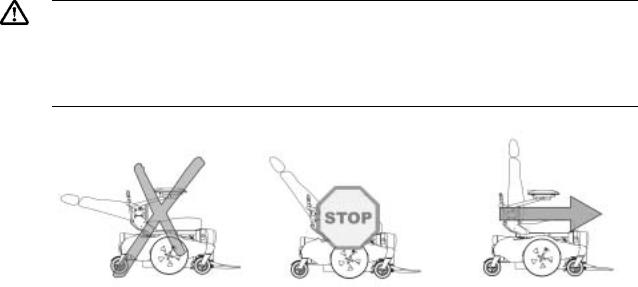
2.5Safety Information on Wheelchairs with Recaro Seats
Danger of injury if the wheelchair tips over!
The centre of gravity of a Recaro seat is higher than that of other seats. The Recaro seat is also heavier than other seating systems. The backrests of RECARO seats can be leaned back 90°. For these reasons there is an increased risk of tipping over!
•Never lean the backrest backward more than 45° degrees, and never exceed 15° when driving the wheelchair!
More than 45° |
15°-45° |
0°-15° |
NEVER!! |
Standstill! |
Driving |
20
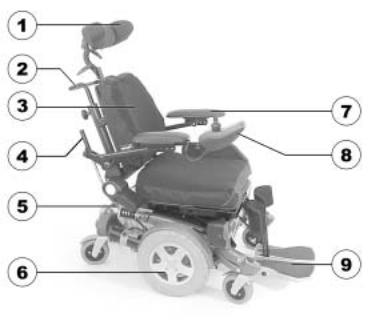
3Key features
1)Headrest (adjustment clamping lever is located behind the headrest)
2)Slide grip
3)Backrest
4)Knob for adjusting armrest angle
5)Disengaging lever
6)Drive wheel
7)Armrest
8)Remote
9)Legrests
21
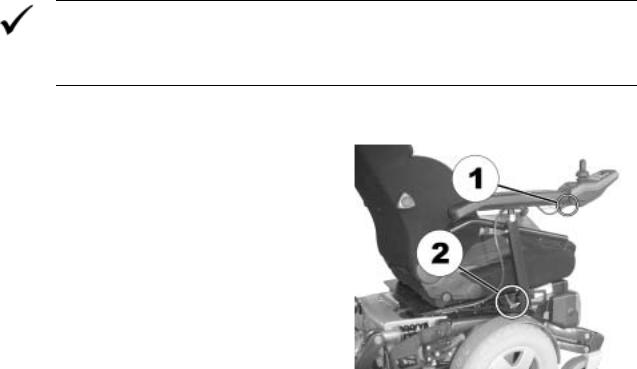
4 Getting in and out of the wheelchair
Important information when side transferring in and out of the wheelchair
In order to side transfer it is necessary for the armrest to either be raised or removed completely depending on the model. A skirtguard can be installed as an option in connection with the parallel sliding armrest. This is attached in the same way as the standard armrest and must also be removed when transferring.
4.1Remove the standard armrest in order to side transfer
Removing the armrest:
•Loosen remote cable (1) from remote.
•Loosen clamping lever (2)
•Remove the side panel from the receptacle
22
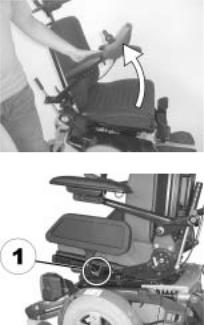
4.2Raise the parallel sliding armrest / remove the skirtguard (optional)
Swivel up armrest
•Swivel armrest up to access from the side.
Removing the skirtguard (optional) to get on:
•Loosen clamping lever (1)
•Remove the skirtguard from the receptacle.
23
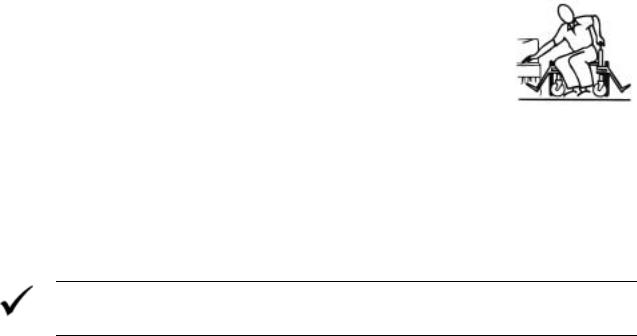
Getting into the wheelchair:
•Position your wheelchair as close as possible to your seat. This might have to be done by an attendant.
•Switch your wheelchair off.
•Apply the hand brake of your wheelchair (if existing).
•Detach the side part of your wheelchair or swivel it up.
•Now slide into the wheelchair.
Getting out of the wheelchair:
•Drive your wheelchair as close as possible to your seat.
•Switch your wheelchair off.
•Apply the hand brake of your wheelchair (if existing).
•Detach the side part of your wheelchair or swivel it up.
•Now slide onto your new seat.
NOTE:
If you do not have sufficient muscle strength, you should ask other persons for help. Use a sliding board, if possible.
24

5 Driving
5.1Before driving for the first time...
Before you take your first trip, you should familiarise yourself well with the operation of the vehicle and with all operating elements. Take your time to test all functions and driving modes.
NOTE:
If installed, use the restraining systems (seat belts) each time you use the vehicle.
Sitting Comfortably = Driving Safely
Before each trip, make sure that:
•You are within easy reach of all operating controls.
•The battery charge is sufficient for the distance intended to be covered.
•The seatbelt is in perfect order.
25
5.2Taking Obstacles
5.2.1The ”SureStep“ System
The Invacare® Typhoon is fitted with "SureStep" technology. When climbing over obstacles, the front steering wheels are raised using the torque generated by the drive wheels.
Please note that the techniques required for overcoming obstacles for wheelchairs fitted with central drives and "SureStep" technology is completely different to that required for models with front wheel or rear wheel drive.
5.2.2The ”Stability Lock“ System
If your wheelchair is fitted with a lifter and this is raised, this will restrict the function of the "SureStep" system due to the "Stability Lock". The "Stability Lock" increases the tilt stability of the wheelchair and prevents front wheel spring deflection on the "Walking Beams" when braking or when descending slopes.
26
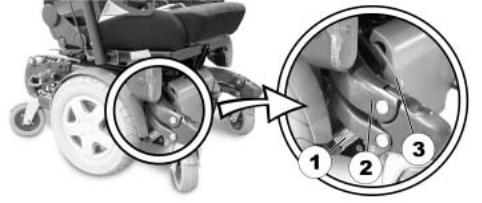
5.2.3The components of the "SureStep" and the "Stability Lock" system
The diagram below shows the components in the "SureStep" system with the side panels removed.
(1) Anti-Dive Spring, (2) Walking Beam und (3) Stability Lock.
5.2.4Maximum obstacle height
Your wheelchair can overcome obstacles and kerbs with the following heights.
•10 cm
27

5.2.5Safety information when ascending obstacles
CAUTION: Danger of Tipping Over!
•Never approach obstacles at an angle!
•Put your backrest into an upright position before climbing an obstacle!
CAUTION: The wheelchair can be damaged if an obstacle is approached at excessive speed.
•Always approach obstacles at low speed! As soon as the front wheels come into contact with the obstacle, stop for a short period before driving over the obstacle! Wheelchairs fitted with centre drive have a special mechanism (Walking Beam) for overcoming obstacles. Approaching at speed can actually lead to mechanical damage.
5.2.6Safety information when descending obstacles
CAUTION: The wheelchair can tip over to the front when descending from an obstacle that is too high as there can be spring deflection of the front swivel wheels.
•Please pay particular attention to tilt resistance when driving down off an obstacle!
•If available, please set your seat tilt to a greater value than normal!
•The maximum obstacle height refers to ascent as well as descent. Never descend from obstacles that are higher than those you may ascend!
28
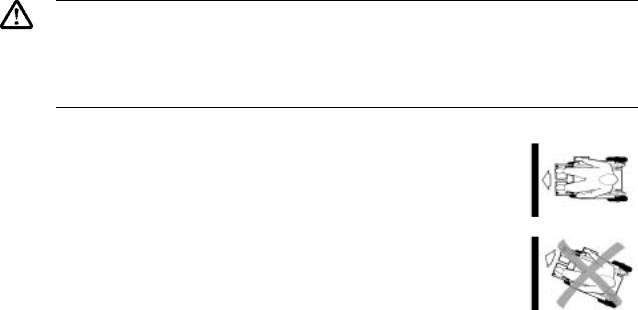
5.2.7The correct way to overcome obstacles
CAUTION: If the lifter is raised, the drive wheels can lose ground contact when descending from obstacles or driving on an uneven surface! The "Stability Lock" prevents “Walking Beam“ spring deflection when the lifter is raised!
•Never descend from obstacles when the lifter is raised or drive on an uneven surface!
•In the event of the drive wheels losing ground contact, the lifter must be lowered so that the drive wheels come into contact with the ground again.
Ascending and descending
The same approach applies to both ascending and descending obstacles:
•Approach the obstacle or the kerb slowly and at a right angle.
•Stop shortly before the front wheels come into contact with the obstacle.
•Check the position of the front wheels. They must be in driving direction and vertical to the obstacle!
•Approach slowly and keep at a consistent speed until the rear wheels have also passed over the obstacle.
Right
Wrong
29

5.3Driving up and down gradients
The Invacare® Typhoon has a maximum hill-climbing ability without overturning of 20%.
WARNING: Danger of tipping over!
•Only ever drive downhill at a maximum of 2/3 of the top speed!
•Avoid sudden changes of direction or abrupt braking when driving on slopes!
•Always return the backrest of your seat or the seat tilt to an upright position before ascending slopes! We recommend that you position the seat backrest or the seat tilt slightly to the rear before descending slopes!
•If the lifter is raised drive mode is only used for positioning and not for regular drive operation! Lower the lifter before ascending a slope!
•Never attempt to ascend or descend a slope on slippery surfaces or where there is a danger of skidding (such as wet pavement, ice etc)!
•Avoid trying to get out of the vehicle on an incline or a gradient!
•Always drive straight in the direction the road or path you are on goes, rather than attempting to zigzag!
•Never attempt to turn around on an incline or a slope!
5.4Parking and stationary
When parking your vehicle or if your vehicle is stationary for a prolonged period:
•Switch the vehicle's power system off (ON-/OFF key).
•Activate your anti-theft lock, if existing.
30
